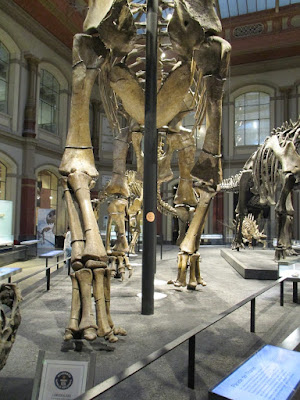Two skeletal dinosaurs compete for the status of the museum's 'icon' in the public imagination - and it's amusing to think how they are near opposites of each other. On the one hand, there's the towering mounted Giraffatitan - in reality a composite, not that most people will ever know. It feels almost industrial in its massive sturdiness, like it was designed by Isambard Kingdom Brunel with the purpose of allowing express trains to traverse a canyon while simultaneously flaunting the engineering prowess of the Saurian Empire. In short, it's every bit as breathtaking as you might expect.
Of course, the glorious setting helps enormously in showing the beast(s) off. The dinosaur hall is uncommonly bright and airy, and spacious enough to allow views of its centrepiece attractions from virtually every angle. It's one thing to finally be able to size up the museum's Giraffatitan mount in person, but quite another to be able to wander around it and take in the sheer size of its columnar forelimbs, the breadth of its ribcage, and just how high its (comparatively) tiny head cranes over the puny primates below. Yes, it's awesome. Poor old Dippy nearby can't help but be overshadowed.
Just because you'd otherwise require a decent pair of binoculars to view it, there's a cast of the skull mounted at ground level. It's a nice idea, particularly because one can forget the broadness of the muzzles on these animals when one's only viewing two dimensional skeletals. It probably didn't have a terribly pretty face, but then at least it wasn't Camarasaurus.
Of course, Giraffatitan is famously joined by other stars of the Tendaguru formation. To its right sits Dicraeosaurus, it of the curiously short neck and tall neural spines. I'm very fond of this mount of this compact sauropod - I think it's because it seems to be bending down to greet us, and smiling with it. (You'll note that all of the Berlin sauropods sport just the single thumb claw on their hands. It makes me happy.)
To the left and slightly behind the Giraffatitan sits Kentrosaurus, which while looking notably more dynamic than before its overhaul (that super-spiny tail is almost being brandished at passers by), it still sports curiously sprawling forelimbs. Huh. There's also the matter of that much-disputed pair of spikes, which sit on the shoulders...for now.
Oh, and there's also Dippy. Why the American Diplodocus carnegii among all these African animals? As was explained to me by a certain highly talkative German scientist (let's call him 'Dr M'), diplodocid material is known from the Tendaguru, but not enough to mount anything near a complete skeleton; therefore, Diplodocus is used as a stand-in. Also, the museum were given that cast back in the day, and it's just too cool not to use.

Ahead and to the left of Dippy, Elaphrosaurus is mounted as if pursuing Dysalotosaurus. For those more used to seeing Morrison formation animals, the latter is quite obviously a Dryosaurus-alike, and has indeed been sunk into that genus in the past. However, Elaphrosaurus is an altogether stranger proposition. This mount, posed as if running, emphasises the theropod's unusual legginess; it was probably quite fleet of foot for its size. However, what's truly bizarre is the combination of long legs with a very long, shallow torso. The arms and head on this mount are necessarily speculative and distinctly predatory in appearance. One can't help but wonder if, had these parts been sculpted following the publication of beak-mouthed Limusaurus, some rather different decisions would have been made. Still, it remains impossible to say exactly what this animal's dietary habits were.
A view from behind really helps emphasise how long and lean Elaphrosaurus was.
Adjacent to Elaphrosaurus is another Morrison stand-in - Allosaurus fragilis, which looks like a real bruiser next to the lankier African animal. Apparently, this mount was deliberately made as 'generic as possible' and is not intended to represent a single specimen, simply because it is really just a substitute for fragmentary Tendaguru allosaurs (and you thought his shoes were made of leather). A real Tendaguru allosaur femur is displayed in a case nearby. In spite of this, it can't help but draw attention to itself because of the stunningly detailed fleshed-out model head that somebody saw fit to affix to the front. Some have argued that it doesn't really work, but I'd argue that it does, if only because of the dividing glass partition (the head juts out into the admission kiosk/cloakroom area). It's also really gorgeous, and I'd like a copy for my living room, please. I'll update this post with a link to the Kickstarter campaign shortly.
I haven't yet mentioned that other iconic dinosaur; you know, the one that's the polar opposite of a gallumphing great sauropod to gaze upon, ye mighty, and despair. It's Archaeopteryx, of course; a delicate little fellow sequestered away in its own special alcove, an impossibly dainty and beautiful specimen treated quite justifiably like a masterful work of art. Cue heavenly chorus*.
The Urvogel isn't the only Solnhofen specimen on show of course; consider this beautiful Rhamphorynchus, just one among a huge number of stunningly preserved examples of the Solnhofen fauna. There is an emphasis on the contemporaneous (or near-as-damn-it) nature of the Solnhofen and Tendaguru ecosystems - helping to build a wider view of the Jurassic world, rather than one limited to one locality.
There's a lot more to the museum than this one hall, of course, including some sublime award-winning taxidermy featuring Archaeopteryx's extant relatives. And I may well get to all that in a future post. For now, however, let us close on a photograph of what Brian Switek tastefully referred to as 'dinobutt' over on our Facebook page. Enjoy.
*Credit to Peng.















No comments:
Post a Comment